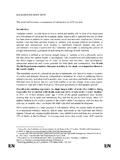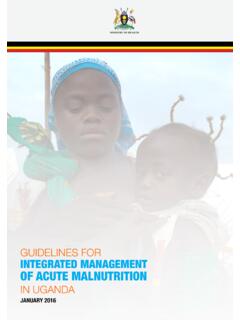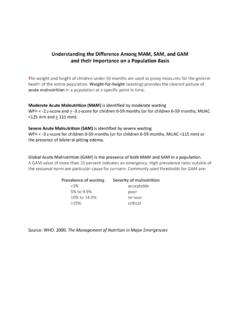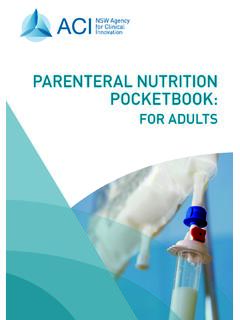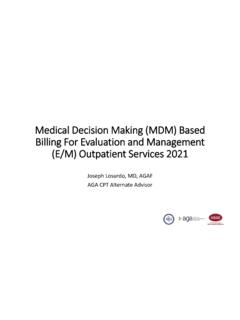Transcription of Malnutrition Screening Tools: Comparison Guide
1 This is a consensus document from Dietitian/ Nutritionists from the Nutrition Education Materials Online, "NEMO", team Disclaimer: Reviewed: May 2017 Due for review: May 2019 Validated Malnutrition Screening and Assessment Tools: Comparison Guide General notes on Screening tools1: - The Screening tools outlined below are relatively similar, using parameters such as recent weight loss, recent poor intake/ appetite and body weight measures and providing a numerical score to categorise risk of Malnutrition .
2 - All tools listed generally perform well2 with the exception of the nursing home population where all current tools carry limitations in relation to assessing nutritional status and predicting outcomes3. - When choosing a Screening tool that is suitable for your facility, it is important to consider the following: o Ensure the tool is validated to the population4 o Complexity: If the tool requires calculations ( BMI, percentage weight loss) or is lengthy with many parameters, it is likely to be more time consuming and subject to error. This may also result in a low compliance with Screening .
3 O Sensitivity: As Screening is only the first step to identify those that require nutritional assessment, a Screening tool needs to achieve a high sensitivity (that is, identifies all those at risk), even if this is at the expense of a high specificity (or false positives). - Other factors to consider: Who will perform Screening ? How can Screening be incorporated into current procedures? What action will be taken for those screened at risk? Name Author, year, country Patient Population Nutrition Screening parameters Criteria for risk of Malnutrition When/ by whom Reliability established Validity established Malnutrition Screening Tool (MST)5 Ferguson et al.
4 (1999) Australia acute adults: inpatients & outpatients5,6 including elderly 7 Residential aged care facilities7 Recent weight loss Recent poor intake Score 0-1 for recent intake Score 0-4 for recent weight loss Total score: >2 = at risk of Malnutrition Within 24 hours of admission and weekly during admission Medical, nursing, dietetic, admin staff; family, friends, patients themselves Agreement by 2 Dietitians in 22/23 (96%) cases Kappa = Agreement by a Dietitian & Nutrition Assistant in 27/29 (93%) of cases Kappa = ; and 31/32 (97%) of cases Kappa = Compared with Subjective Global Assessment (SGA) and objective measures of nutrition assessment.
5 Patients classified at high risk had longer length of stay. Sensitivity = 93% Specificity = 93% This is a consensus document from Dietitian/ Nutritionists from the Nutrition Education Materials Online, "NEMO", team Disclaimer: Reviewed: May 2017 Due for review: May 2019 Name Author, year, country Patient Population Nutrition Screening parameters Criteria for risk of Malnutrition When/ by whom Reliability established Validity established Mini Nutritional Assessment Short Form (MNA-SF) 8 Rubenstein et al.
6 (2001) United States Elderly May be best used in community, sub- acute or residential aged care settings, rather than acute care2 Recent intake Recent weight loss Mobility Recent acute disease or psychological stress Neuropsychological problems BMI Score 0-3 for each parameter Total score: < 11 = at risk, continue with MNA On admission and regularly Not stated Not reported Compared to MNA and clinical nutritional status. Sensitivity = Specificity = 100% Diagnostic accuracy = Compared with SGA in older inpatients Sensitivity = 100% Specificity = 52%2 Malnutrition Universal Screening Tool (MUST) 9 Malnutrition Advisory Group, BAPEN (2003) UK Adults acute and community BMI Weight loss (%) acute disease effect score Score 0 3 for each parameter.
7 Total score: >2 = high risk 1 = medium risk 0 = low risk Initial assessment and repeat regularly All staff able to use Quoted to be internally consistent and reliable. Very good to excellent reproducibility Kappa = Face validity, content validity, concurrent validity with other Screening tools (MST and NRS)10 Predicts mortality risk & increased length of stay and discharge destination in acute patients11 Nutrition Risk Screening (NRS-2002)12 Kondrup et al. (2003) Denmark acute adult Recent weight loss (%) Recent poor intake (%) BMI Severity of disease Elderly Score 0-3 for each parameter Total score: > 3 = start nutritional support At admission and regularly during admission Medical and nursing staff Good agreement between a Nurse, Dietitian and Physician Kappa = Retrospective and prospective analysis.
8 Tool predicts higher likelihood of positive outcome from nutrition support and reduced length of stay among patients selected at risk by the Screening tool & provided nutrition support. Table adapted, with permission, from Banks (2008)1 For more information about nutrition Screening tools and how to implement nutrition Screening process in your healthcare facility, refer to the Evidence Based Practice Guidelines for the Nutritional Management of Malnutrition in Adult Patients across the Continuum of Care13. This is a consensus document from Dietitian/ Nutritionists from the Nutrition Education Materials Online, "NEMO", team Disclaimer: Reviewed: May 2017 Due for review: May 2019 Validated Nutrition Assessment Tools: Comparison Guide General notes on assessment tools12: The tools outlined below are recommended because of their higher sensitivity and specificity at predicting nutritional status.
9 Training is required for the correct application of nutrition assessment tools. A link to a training DVD on completing the SGA is available on the NEMO website. Name Author, year Setting and Patient Population Nutrition assessment parameters Rationale/ Clarification Subjective Global Assessment (SGA) Detsky, et al. 198714 Setting: Acute14,15,16 Rehab17 Community18 Residential Aged Care 19 Patient group: Surgery14 Geriatric 17,18,19,20 Oncology15 Renal16 Includes medical history (weight, intake, GI symptoms, functional capacity) and physical examination Categorises patients as: - SGA A (well nourished) - SGA B (mild-moderate Malnutrition ) or - SGA C (severe Malnutrition ) Requires training Easy to administer Good intra- and inter-rater reliability Patent Generated Subjective Global Assessment (PG-SGA) Ottery, F.
10 2005 21 Setting: Acute22-24 Patient group: Oncology22 Renal23 Stroke24 Includes medical history (weight, intake, symptoms, functional capacity, metabolic demand) and physical examination Categorises patients into SGA categories (A, B or C) as well as providing a numerical score for triaging. Global categories should be assessed as per SGA. Numerical score assists in monitoring changes in nutritional status Easy to administer Scoring can be confusing but this can be addressed through training Patients can complete the first half of the tool Mini-Nutritional Assessment (MNA) Guigoz Y et al.










